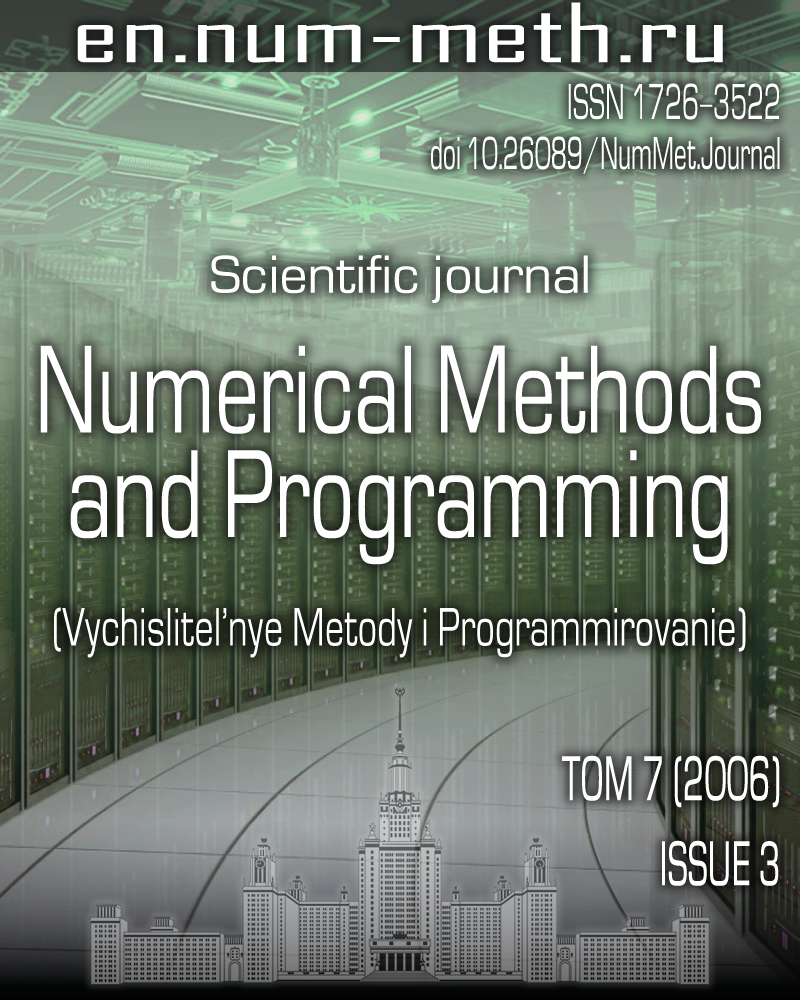Estimation of geometric nonlinearity effect on mathematical simulation of tectonic processes
Keywords:
Abstract
Nonlinear equations of deformable solid mechanics are applied for the mathematical simulation of tectonic processes. All three possible types of nonlinearities are used in the formulation of equations: material, geometric, and contact ones. We consider the tectonic processes for which the simulation is necessary to use the material and contact nonlinearities. The importance of accounting for the geometric nonlinearity of equations of deformable solid mechanics is studied when solving typical problems of tectonic processes simulation. The problem is solved on the thrust fault of a deformable plate on an absolutely rigid solid. The solution is carried out numerically by using the MSC.Marc 2005 code. The finite element method is used for spatial discretization of the equations of deformable solid mechanics. The step-by-step procedure with an iterative solution refinement is used for time integration of equations. The plate lower part is modeled by an elasto-plastic material, whereas the plate upper part is modeled by a brittle material. The performed computations have shown the importance of accounting for the geometric nonlinearity. The plate rupture scenario is developed in the geometrically linear approximation. This scenario differs significantly from the plate rupture scenario obtained when solving the same problem with taking into account the geometric nonlinearity of deformation.
Published
Issue
Section
References
- Коробейников С.Н. Нелинейное деформирование твердых тел. Новосибирск: Изд-во СО РАН, 2000.
- MARC Users Guide. Vol. A: Theory and users information. MSC. Software Corporation, 2005.
- Zienkiewicz O.C., Taylor R.L. The Finite Element Method. London: McGraw Hill, 1991.
- Bathe K.-J. Finite element procedures in engineering analysis. Englewood Cliffs: Prentice Hall, 1982.
- Голованов А.И., Бережной Д.В. Метод конечных элементов в механике деформируемых твердых тел. Казань: ДАС, 2001.
- Williams C.A., Richardson R.M. A rheologically layered three-dimensional model of the San Andreas fault in Central and Southern California // J. Geophysical Research. 1991. 96, N B10. 16.597-16.623.
- Brown C.D., Phillips R.J. Flexural rift flank uplift at the Rio Grande rift, New Mexico // Tectonics. 1999. 18, N 6. 1275-1291.
- Brown C.D., Phillips R.J. Crust-mantle decoupling by flexure of continental lithosphere // J. Geophysical Research. 2000. 105, N B6. 13.221-13.237.
- Albert R.A., Phillips R.J., Dombard A.J., Brown C.D. A test of the validity of yield strength envelopes with an elastoviscoplastic finite element model // Geophys. J. Int. 2000. 140. 399-409.
- Vanderhaeghe O., Medvedev S., Fullsack P., Beamont C., Jamieson R.A. Evolution of orogenic wedges and continental plateaux: insights from crustal thermal-mechanical models overlying subducting mantle lithosphere // Geophys. J. Int. 2003. 153. 27-51.
- Zhong S., Paulson A., Wahr J. Three-dimensional finite-element modelling of Earth’s viscoelastic deformation: effects of lateral variations in lithospheric thickness // Geophys. J. Int. 2003. 155. 679-695.
- Fuller C.W., Willet S.D. Formation of forearc basins and their influence on subduction zone earthquakes // Geology. 2006. 34, N 2. 65-68.
- Коробейников С.Н., Полянский О.П., Лиханов И.И., Свердлова В.Г., Ревердатто В.В. Математическое моделирование надвига как причины формирования андалузит-кианитовой метаморфической зональности в Енисейском кряже // Докл. РАН. 2006. 408, № 4. 512-516.
- MARC Users Guide. Vol. E: Demonstration Problems. MSC. Software Corporation, 2005.
- PATRAN Users Guide. MSC. Software Corporation, 2005.
- Kleiber M. Incremental finite modelling in non-linear solid mechanics. Chichester: Ellis Horwood, 1989.
- Osias J.R., Swedlow J.L. Finite elastic-plastic deformation. Theory and numerical examples // Intern. Journal Solids Structures. 1974. 10, N 3. 321-339.
- McMeeking R.M., Rice J.R. Finite element formulations for problems of large elastic-plastic deformation // Intern. Journal Solids Structures. 1975. 11. 601-616.
- Аннин Б.Д., Коробейников С.Н., Шутов А.В. Моделирование хрупкого разрушения упругих блоков // Труды Всероссийского совещания «Напряженное состояние литосферы, ее деформирование и сейсмичность» (Иркутск, Институт земной коры СО РАН, 26,- ,29 августа 2003 г.). 愦灭;percentРед. Шерман С.И. 225-228.
- MARC Users Guide. Vol. C: Program Input. MSC. Software Corporation, 2005.
- Работнов Ю.Н. Механика деформируемого твердого тела. М.: Наука, 1988.


